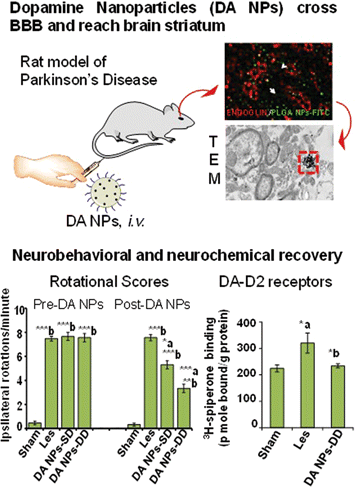Nanoparticle drug reverses Parkinson's-like symptoms in rats

As baby boomers age, the number of people diagnosed with Parkinson's disease is expected to increase. Patients who develop this disease usually start experiencing symptoms around age 60 or older. Currently, there's no cure, but scientists are reporting a novel approach that reversed Parkinson's-like symptoms in rats. Their results, published in the journal ACS Nano, could one day lead to a new therapy for human patients.
Rajnish Kumar Chaturvedi, Kavita Seth, Kailash Chand Gupta and colleagues from the CSIR-Indian Institute of Toxicology Research note that among other issues, people with Parkinson's lack dopamine in the brain. Dopamine is a chemical messenger that helps nerve cells communicate with each other and is involved in normal body movements. Reduced levels cause the shaking and mobility problems associated with Parkinson's. Symptoms can be relieved in animal models of the disease by infusing the compound into their brains. But researchers haven't yet figured out how to safely deliver dopamine directly to the human brain, which is protected by something called the blood-brain barrier that keeps out pathogens, as well as many medicines. Chaturvedi and Gupta's team wanted to find a way to overcome this challenge.
The researchers packaged dopamine in biodegradable nanoparticles that have been used to deliver other therapeutic drugs to the brain. The resulting nanoparticles successfully crossed the blood-brain barrier in rats, released its dopamine payload over several days and reversed the rodents' movement problems without causing side effects.
More information: Trans-Blood Brain Barrier Delivery of Dopamine Loaded Nanoparticles Reverses Functional Deficits in Parkinsonian Rats, ACS Nano, Article ASAP, DOI: 10.1021/nn506408v
Abstract
Sustained and safe delivery of dopamine across the blood brain barrier (BBB) is a major hurdle for successful therapy in Parkinson's disease (PD), a neurodegenerative disorder. Therefore, in the present study we designed neurotransmitter dopamine-loaded PLGA nanoparticles (DA NPs) to deliver dopamine to the brain. These nanoparticles slowly and constantly released dopamine, showed reduced clearance of dopamine in plasma, reduced quinone adduct formation, and decreased dopamine autoxidation. DA NPs were internalized in dopaminergic SH-SY5Y cells and dopaminergic neurons in the substantia nigra and striatum, regions affected in PD. Treatment with DA NPs did not cause reduction in cell viability and morphological deterioration in SH-SY5Y, as compared to bulk dopamine-treated cells, which showed reduced viability. Herein, we report that these NPs were able to cross the BBB and capillary endothelium in the striatum and substantia nigra in a 6-hydroxydopamine (6-OHDA)-induced rat model of PD. Systemic intravenous administration of DA NPs caused significantly increased levels of dopamine and its metabolites and reduced dopamine-D2 receptor supersensitivity in the striatum of parkinsonian rats. Further, DA NPs significantly recovered neurobehavioral abnormalities in 6-OHDA-induced parkinsonian rats. Dopamine delivered through NPs did not cause additional generation of ROS, dopaminergic neuron degeneration, and ultrastructural changes in the striatum and substantia nigra as compared to 6-OHDA-lesioned rats. Interestingly, dopamine delivery through nanoformulation neither caused alterations in the heart rate and blood pressure nor showed any abrupt pathological change in the brain and other peripheral organs. These results suggest that NPs delivered dopamine into the brain, reduced dopamine autoxidation-mediated toxicity, and ultimately reversed neurochemical and neurobehavioral deficits in parkinsonian rats.
Journal information: ACS Nano
Provided by American Chemical Society

















